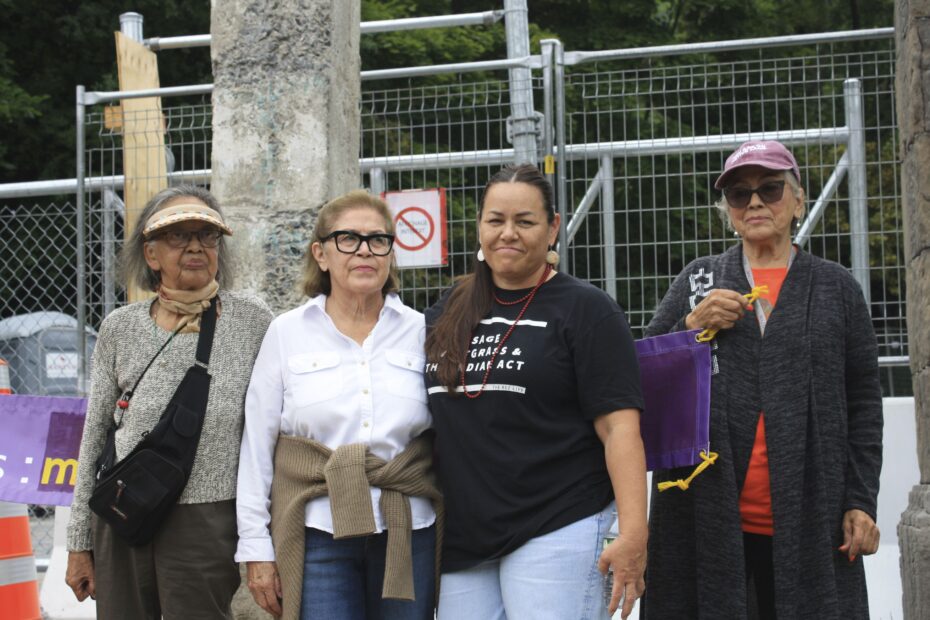After losing their bid to halt construction at the former Royal Victoria Hospital site last month, the Kanien’kehá:ka Kahnistensera (Mohawk Mothers) have expressed concern regarding the archaeological excavation overseen by McGill and the Société québécoise des infrastructures (SQI).
McGill plans to develop the Royal Vic site into a new research and teaching facility, known as the New Vic Project. However, last year, the Mohawk Mothers entered a legal battle with McGill, fighting for an archaeological examination of the site to find potential burial sites from the MK-Ultra experiments conducted by the CIA and McGill in the 1950s and 60s at the site. After winning their case, archaeological work began last April as part of a Settlement Agreement that was reached between the Mohawk Mothers, McGill, and the SQI.
Tensions between the Mohawk Mothers and the parties involved in the construction at the Royal Vic site have continued to rise since the start of archaeological work. The Mohawk Mothers have condemned the actions taken by McGill and the SQI at the site, as the archaeological work is not Indigenous-led. In August, archeological work was halted due to a security incident involving one of the cultural monitors and a security guard.
More recently, the Mohawk Mothers filed an emergency court order for construction at the site to be suspended, claiming that McGill and the SQI had been breaching the Settlement Agreement. The hearing took place on September 14 and revolved around the issue of “mapping” and a disregard for archeological techniques by McGill and the SQI. As part of the Settlement Agreement, an independent archaeologist panel was erected to ensure the proper archaeological techniques employed at the site, specific to the mapped-out zones. However, after McGill claimed that the initial stage of the archeological investigation had been completed in September, they disbanded the independent panel.
Diane, a member of a solidarity group, told the Daily in an interview: “[the disbandment] was a unilateral decision by McGill. That’s always the way it works, although, paragraphs 1 and 16 of the injunction state that this investigation should be Kahnistensera and MK-Ultra survivor-led.” Without the archaeological panel in place, McGill and the SQI reserved the rights to interpret excavation results. “McGill is refusing to share the Ground-penetrating radar (GPR) data with the Mohawk Mothers as well as the archaeological panel while they were active,” said Diane.
The McGill Media Relations Office (MRO) told the Daily that “information is shared between the parties as stipulated in the Settlement Agreement.”
During the September 14 hearing, McGill and the SQI told the court to dismiss the request for construction to be halted; the groups stated that the agreement had been followed and construction was occuring in an area where no burial sites are likely to be found. The judge did not grant the Mohawk Mothers their requested emergency injunction.
Another focal point in the alleged breach of the Settlement Agreement surrounds the removal and transportation of soil to a private site for inspection. In an October 12 press conference attended by the Daily, Mohawk Mother Kwetiio said that she felt “totally betrayed” by McGill and the SQI’s handling of this process. She argued that if any evidence were to be uncovered, moving these piles instead of examining them on the site would allow McGill to escape accountability. Nevertheless, the Daily observed the piles being removed later that week. The MRO confirmed to the Daily that the piles had been moved at the request of the archaeologists on October 3 and “was placed in a secure perimeter to allow the archeologists to sift through it.” The MRO claimed that the Mothers were informed of this on October 3.
Kwetiio claimed that anomalies in priority zone 11 had not been adequately investigated. Three different teams of historic human remains detection dogs (HHRDD) detected possible human remains in that zone, and detections made by HHRDD are about 95 per cen accurate, reaching up to 15 feet. Kwettio additionally expressed frustration that the Mohawk Mothers were prohibited from investigating the interiors of buildings within the 10 meter radius of where the HHRDD detected possible remains.
“We inquired many times if these dogs can smell through [buildings] and they said yes, there’s a pipe leading from inside to outside of the building and yet we still do not know where those three different teams of dogs detected [human remains],” she explained. According to Kwetiio, the reason given for not allowing the Mothers to investigate inside the building was a risk of asbestos.
Diane elaborated on the construction happening inside the building in the interview with the Daily. “The Kahnistensera witnessed construction workers inside this building – right where they’re fighting to have access. The workers were demolishing something, and when the Kahnistensera were worried, of course, they asked, ‘what are you doing?’ [The workers] refused to say anything.”
The Mothers are not the only ones upset with how McGill has been handling this case. Special Interlocutor Kimberly Murray, one of Canada’s leading experts on unmarked graves associated with residential schools, told The Eastern Door that “everything they do is a misstep, and is not good for reconciliation, and is not Indigenous led.” Like the Mohawk Mothers, she decried McGill’s lack of transparency as well as a disrespect for her office.
At the Quebec Superior Court on October 27, the Mohawk Mothers will detail breaches of the Settlement Agreement made by McGill and the SQI. At the end of the interview with the Daily, Diane said: “We’re calling all supporters, all citizens who are sensitive to this kind of struggle to show support to the Kahnistensera in front of the court.”
Names in this article have been changed to protect the anonymity of sources.

